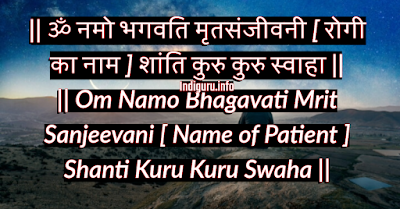The Mritsanjeevani Mantra is universally believed to the the most powerful and potent Hindu Healing Mantra, which has been described in most ancient Hindu Religious Scriptures as the Mantra that defeats death or the life giving Mantra. This Maha Mantra originates from Bhagwan Shiva who blessed the Guru of the Rakshasas Shukracharya with this Mantra and the power to give life to the dead.
The Mantra should be chanted along with the medicines and medical treatment to make the treatment more effective. This site is not in a position to give any guarantee for the success of the Great Healing Mantra.
There are many versions of the Mrit Sanjeevani Mantra, which is sometimes also called Mahamrityunjaya Mantra; the Great Death Conquering Mantra. This Great Healing Mantra is connected to the Mrit Sanjeevani or Sanjeevani Vanaspati that has been described in many Hindu Texts, including the Mahabharata. However, at the present moment of time no one can identify this Magical Healing Herb or where it can be found.
The simple but most potent version of the Mrit Sanjeevani Mantra given in this post is the Laghu or Short Version of this Mantra, which can be recited by people suffering from sickness and diseases, incurable and serious diseases along with their medication to make the medicines more effective.
The good thing about this version of the Mrit Sanjeevani Mantra is that it can also be recited by the patient himself and also for healing others who are suffering from sickness and ailments.
The Technique of Reciting the Mrit Sanjeevani Mantra to heal yourself or others: The Devotee can recite the Mrit Sanjeevani Mantra shown is the image 108 times using a Rudraksha Beads Chanting Rosary. The words रोगी का नाम / Name of Patient in the Mantra must be replaced with your name or the name of patient. Notes: The Hindi version of this Healing Mantra can be seen here: Rogon Se Chutkara Pane Ka Chamatkari Laghu Mrit Sanjeevani Mantra.
The simple but most potent version of the Mrit Sanjeevani Mantra given in this post is the Laghu or Short Version of this Mantra, which can be recited by people suffering from sickness and diseases, incurable and serious diseases along with their medication to make the medicines more effective.
The good thing about this version of the Mrit Sanjeevani Mantra is that it can also be recited by the patient himself and also for healing others who are suffering from sickness and ailments.
The Technique of Reciting the Mrit Sanjeevani Mantra to heal yourself or others: The Devotee can recite the Mrit Sanjeevani Mantra shown is the image 108 times using a Rudraksha Beads Chanting Rosary. The words रोगी का नाम / Name of Patient in the Mantra must be replaced with your name or the name of patient. Notes: The Hindi version of this Healing Mantra can be seen here: Rogon Se Chutkara Pane Ka Chamatkari Laghu Mrit Sanjeevani Mantra.
The Mantra should be chanted along with the medicines and medical treatment to make the treatment more effective. This site is not in a position to give any guarantee for the success of the Great Healing Mantra.

Comments
Post a Comment